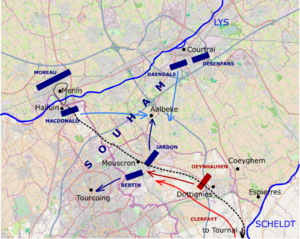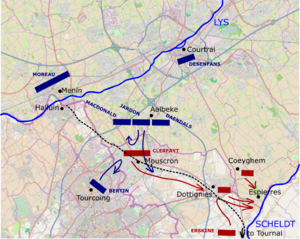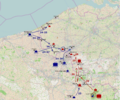Battle of Mouscron facts for kids
Quick facts for kids Battle of Mouscron |
|||||||
|---|---|---|---|---|---|---|---|
| Part of the Flanders campaign in the War of the First Coalition | |||||||
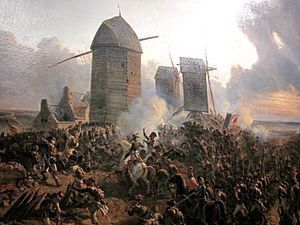 The Battle of Mouscron 1794 by Charles Louis Mozin |
|||||||
|
|||||||
| Belligerents | |||||||
| Commanders and leaders | |||||||
| Strength | |||||||
| Mouscron: 28,000 Menen: 14,000 |
Mouscron: 10,000 Menen: 2,423, 28 guns |
||||||
| Casualties and losses | |||||||
| Mouscron: 1,500, 6 guns Menen: 500, 2 guns |
Mouscron: 1,760, 24 guns Menen: 727, 10 guns |
||||||
The Battle of Mouscron was a series of important fights that happened on April 28–29, 1794. It was part of the French Revolutionary Wars, specifically the War of the First Coalition. During this time, the new French Republic was fighting against several European countries, known as the Coalition.
The battle took place near Mouscron and Menen (also called Menin) in what is now Belgium. The French Army of the North, led by General Jean-Charles Pichegru, attacked northeast towards Menen. They faced Coalition forces, mainly from Austria and Hanover, led by François Sébastien Charles Joseph de Croix, Count of Clerfayt.
The French first started to surround Menen and captured Courtrai. When Austrian troops arrived to help, Clerfayt launched a counterattack on April 28. However, French General Joseph Souham quickly gathered more French soldiers. They pushed the Coalition forces out of the area, leading to a French victory.
Because most of the Coalition army was busy with the Siege of Landrecies, the French were able to advance easily at first. They pushed back the smaller Hanoverian forces. North of the Lys River, a French group led by Jean Victor Marie Moreau began to surround Menen. Meanwhile, Souham's soldiers moved on the south side of the river.
Clerfayt's counterattack at Mouscron had some early success. But Souham, acting on his own, brought together many more French troops. This left Clerfayt's forces completely alone. The Hanoverian soldiers defending Menen, led by Rudolf von Hammerstein, had to break out of the fortress and escape on April 30. The next big fight in this area was the Battle of Courtrai on May 10.
Contents
Why the Battle Happened: The Background
In 1794, the French planned a major attack in the Flanders Campaign. They had about 160,000 soldiers in the Army of the North and 35,000 in the Army of the Ardennes. The Coalition, made up of soldiers from Austria, the Dutch Republic, and others paid by Britain, had about 150,000 troops.
The Coalition wanted to push into France from the north and northeast to reach Paris. General Pichegru was in charge of the two French armies. Their lines stretched from Dunkirk on the North Sea to Maubeuge. The French had more soldiers, but the Coalition troops were generally better trained.
The Coalition army was led by Austrian Prince Josias of Saxe-Coburg-Saalfeld. He was supported by British Prince Frederick, Duke of York and Albany. Both armies used a "cordon system," meaning they spread out their troops to guard the entire border.
Coburg started the 1794 campaign by surrounding Landrecies with 85,000 soldiers. Pichegru tried twice to help the city, but both attempts failed. On April 26, one French group was badly beaten at the Battle of Beaumont-en-Cambresis. The French lost 7,000 soldiers and many cannons. During this defeat, Pichegru's battle plans were captured. These plans showed the Coalition exactly where the French would attack in Flanders. Landrecies surrendered on April 30, 1794, after these French failures.
Pichegru's Attack Begins
On April 13, 1794, General Pichegru was in Lille planning his attack. His army was divided into several groups. General Jean Victor Marie Moreau had about 16,000 troops near Cassel. General Joseph Souham had a very large group of nearly 32,000 soldiers near Lille.
General François Sébastien Charles Joseph de Croix, Count of Clerfayt was in charge of defending the Coalition's right side with 28,000 troops. On April 23, a French force moved towards Denain, threatening Coalition troops there. Clerfayt was ordered to move his soldiers south to Denain. This helped stop the French from cutting off communication between the Coalition armies. However, Clerfayt was annoyed because these orders kept him too far away to quickly respond to an attack on Menen.
On April 25, Pichegru began his advance on Menen and Kortrijk (Courtrai). Moreau's troops moved along the north bank of the Lys River and started firing cannons at Menen on April 28. Souham's soldiers advanced on the south bank of the Lys.
Souham sent Jacques MacDonald with 15,000 troops to capture and hold Mouscron. This was to protect his right side from the Austrians. Souham then took Courtrai with other brigades on April 26. The French forced the 1,500 Coalition troops defending Courtrai to leave. These Coalition troops were mostly Hanoverian soldiers.
First Fights Around Mouscron
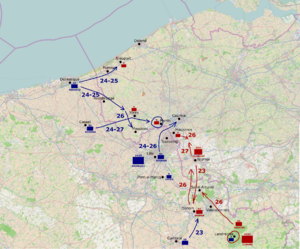
Also on April 26, MacDonald's French forces met Hanoverian troops led by General George von Oeynhausen at Mouscron. Oeynhausen's soldiers moved east to Dottignies and managed to hold their ground.
Moreau and 14,000 French soldiers began to surround Menen on April 27. The Coalition force defending Menen had 2,423 soldiers and was led by Hanoverian General Rudolf von Hammerstein. This group included Hanoverian, Hesse-Kassel soldiers, and French Royalists. They had 22 cannons and six howitzers.
The Battle Begins: April 28
Once the Coalition leaders found Pichegru's plans, Clerfayt was ordered to march his troops west. More soldiers were sent to help Clerfayt.
On April 28, General Oeynhausen counterattacked Mouscron and took it back. The French brigades there were forced to retreat. That evening, Oeynhausen received more Hanoverian soldiers, bringing his strength to 3,600. Clerfayt also arrived with about 10,000 Austrian troops and cannons.
General Souham acted quickly. He ordered Jacques MacDonald to gather several French brigades, totaling 16,000 troops. Souham then sent another brigade to join the attack. In total, about 28,000 French soldiers were ready for battle on April 29.
The Main Fight: April 29
On April 29, Pichegru was again not present at the battle. Souham launched a two-part attack on Clerfayt's 10,000 soldiers at Mouscron. While the main French force attacked from the front, another brigade attacked Clerfayt's left side and behind him.
Clerfayt had been planning to attack and help Menen on April 30, so he was not ready for a counterattack. Even though they were outnumbered three to one, the Coalition troops fought hard. They pushed back the French attacks twice.
At 2:00 PM, Souham demanded one more push. He and MacDonald personally led the final attack. The French had more cannons, which eventually made a big difference. Clerfayt ordered his troops to retreat. The retreat quickly turned into a disorganized run. Luckily, more Coalition soldiers arrived just in time to help stabilize the line. Clerfayt's forces then continued to retreat to Espierres.
What Happened Next
The French Royalist soldiers in Menen knew they would be executed if captured. So, on the night of April 30, the soldiers defending Menen broke out. Led by the Loyal Emigrant Battalion, Hammerstein's men fought their way out to the north. They managed to escape with most of their cannons. The Hanoverians lost 38 killed, 123 wounded, and 387 captured. The Royalists lost 92 killed and 87 wounded. In total, the Coalition lost 727 soldiers and 10 cannons. The French lost about 500 men and two cannons.
In the Battle of Mouscron itself, the Austrians lost 903 soldiers and 11 cannons. The Hanoverians lost 58 killed, 272 wounded, and 527 missing, along with 13 cannons. The total Coalition loss was 1,760 men and 24 cannons. The French suffered about 1,500 casualties and lost six cannons.
After capturing Landrecies, the Coalition moved many soldiers into the area. However, they failed to bring them all together. They sent Clerfayt north of Courtrai, the Duke of York near Tournai, and other forces east of Courtrai.
The Hanoverian cavalry won a small fight at Roeselare on May 4. They lost only 3 killed and 27 wounded, while the French lost 102 soldiers and three cannons. The next day, there was a small fight at Harelbeke with no clear winner. The next important battles were Willems and Courtrai on May 10–12, 1794.
Images for kids



